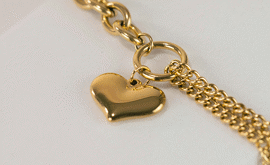Silver Hallmarks: A Guide to Understanding the Marks on Silver
What is a hallmark?
A hallmark is a legal mark that is stamped or moulded into items made of precious metals like gold and silver. These marks make it easier to identify the metal that has been used, and its purity. Precious metals are often alloyed with other metals to increase their strength and make them more durable, as pure silver may be easily scratched when used continuously. Silver hallmarks show the details of the amount of pure silver in an item, ensuring that a precise valuation can be made.
The history of silver hallmarks UK
Silver hallmarks have a long history in the UK, dating back to the late 15th century, and are considered to be one of the earliest forms of customer protection. At the time, silver was used as circulating currency, so it was seen to be important that all silver items met the standard of the country's money. This led to the creation of the term "sterling silver," and it was legally required that all silver items be tested and stamped with a hallmark.
Testing of the silver was carried out by "The Worshipful Company of Goldsmiths," who met in Goldsmiths Hall, London, giving us the origin of the term "hallmark". In 1973, the Hallmarking Act stated that all silver items weighing over 1 gram must be hallmarked.
Today, the system of silver hallmarking in the UK is regulated by assay offices in London, Birmingham, Edinburgh, and Sheffield, with each having its own hallmark symbol.
What do the different markings on silver mean?
Hallmarked silver items feature a range of marks that provide important information. There are three compulsory symbols that are legally required on silver items weighing over 1g:
- The sponsor mark: This is the manufacturer or sponsor which is usually a mint, refiner, or jeweller. These silver marks typically consist of two or more letters, often initials, which represent the manufacturer’s name or business.
- The fineness mark: This details the purity of the silver, shown in parts per thousand. For example, a 925 hallmark means the item is 92.5% pure silver, also known as sterling silver. Common UK silver fineness marks include:
- 999: Fine silver
- 958: Britannia silver
- 925: Sterling silver
- 800: Continental silver
- The assay office mark: This symbol tells us which official assay office carried out the testing. The UK has four primary assay offices, and each has its own symbol:
- Birmingham: Anchor
- London: Leopard head
- Edinburgh: Castle
- Sheffield: Rose
Over time, there have also been additional assay offices in the UK.
Another important mark that can appear is the silver year mark. This is shown as a letter, and corresponds to the year the silver item was hallmarked. These silver date marks can help trace the age of the piece. A stamp bearing the lion passant facing left may also be found, which confirms the item is made of sterling silver. Since 1999, the silver year mark and lion passant have both been optional.
Do silver coins and bars have a hallmark?
Silver coins and bars do not require hallmarks. The government and mints guarantee the precious metal content of their silver coins, which makes it easy for buyers of bullion to assess their value. Silver bars are also exempt from hallmarking, as they are considered raw materials and not finished products. Refiners and mints often stamp details such as weight and fineness on the silver coin or bar rather than applying a hallmark.
Selling your hallmarked silver
At Atkinsons, we buy silver coins and bars, as well as hallmarked silver jewellery. This includes silver jewellery items that are in good condition, broken, or simply unwanted. We will also buy other silver items such as tableware, cutlery, snuff boxes, matchbox vestas, cigarette cases, and ashtrays. With over 35 years of industry-leading experience and knowledge, you can confidently sell your silver items to us with ease, and count on a fair price with no hidden fees. For more details, visit our ‘sell to us’ page.
Conclusion
Silver hallmarks have played an important role in verifying the authenticity and purity of many silver items for hundreds of years. By understanding the different marks, you can confidently assess the value of your silver. Whether you're buying or selling, knowing about these hallmarks can ensures that you are dealing with genuine silver items.
This blog represents one person’s opinion only. Please note, gold and silver prices may go down as well as up. Atkinsons Bullion & Coins accepts no responsibility for any losses based on information we have provided. We do not offer investment advice. Please carry out your own research before making an investment decision.













